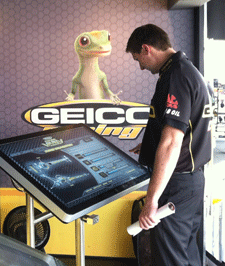Social media is as important today to events as a well-trained brand rep or a smartly wrapped vehicle for two major reasons. One, social brings the ability to measure activation in real time and in a verifiable way. Second, it allows for the amplification of messaging throughout all stages of event planning, execution and follow up to reach a larger number of people.
 “Social media provides metrics and that’s very important for us to be able to ground our work in a new metric,” says Emily Duban, executive vice president of strategy and growth at BeCore.
“Social media provides metrics and that’s very important for us to be able to ground our work in a new metric,” says Emily Duban, executive vice president of strategy and growth at BeCore.
In fact, technology, or the integration with social media, was considered by brands and agencies (58%) to be the most promising event strategy and approach, according to the 2012 EventTrack study.
Still, only 28% of brands say their social media efforts are “very integrated” with their event and experiential marketing, although 49% say these two mediums are “somewhat integrated.” This is a notable difference from what consumers in the survey had to say. Sixty-six percent of consumers reported that social media is “very effective” or “effective” in helping make events and experiences more successful.
Sprint is tapping into the potential of viral sharing on YouTube to support a major event as part of its NASCAR sponsorship.
In April, Sprint wrapped a contest that asked fans to create and post a video on Sprint.com/Speedthat showed their passion for a particular driver. The winning videos introduced the starting lineup of 20 drivers at the NASCAR Sprint All-Star Race at the Charlotte Motor Speedway May 19. The videos were also shown on the track’s high-definition video board and on Speed’s live race broadcast. The contest supported a large, interactive footprint Sprint is NASCAR’s largest partner and executes its footprint at all NASCAR races throughout the season.
“We try to leverage the fact that we are so deeply embedded and synonymous with the sport and the lifestyle that fans love as a way to drive a conversation about our products and services and how we’re different from the competition,” says Tim Considine, director of sponsorship marketing at Sprint.
To improve viral shares on YouTube, Considine says, it’s key to marry the idea for the contest with the passion of the fans.
“Creativity is at a premium these days. There’s no shortage of contests, but the important thing is you have to tap into something that is elemental to whatever it is your sponsoring,” he says.
When Geico planned their sponsorship of the upcoming National Hot Rod Association races later this year, it made sure visitors could easily share their experiences on Facebook.
At the live events throughout 2012, Geico’s 50-foot by 30-foot area will house a number of activities, including the “Engine Build Challenge” where people use drag and drop touch technology to rebuild an engine between heats. Once completed, they watch an animation of their hot rod or motorcycle race down a simulated track and then receive a report and a prompt to share the results with their Facebook fans. A Geico NHRA result appears on the user’s Facebook wall as a status update. The footprint will be at 15 locations, ending at the NHRA Las Vegas Nationals in October. The event and promotion are handled by Redpeg.
Facebook posts were the most influential technology or social media sites and features influencing consumers’ decision to participate in events (61%), followed by emails and e-newsletters (48%) and event and experience website 33%, the EventTrack study found.
“We’re in a world where social media is providing relationship currency, but there’s the physical event, the physical experience and that can be amplified in social media,” Mercedita Roxas-Murray, executive vice president of strategy and brand planning at RedPeg. “For us it’s about how do we get the consumer to immerse in the brand so they walk away feeling something about it. This is being driven by what’s happening with the customer. The end customer is right now in an environment in which technology is playing a major role, so we have to start thinking about how do we start marketing by the smallest interface.”




